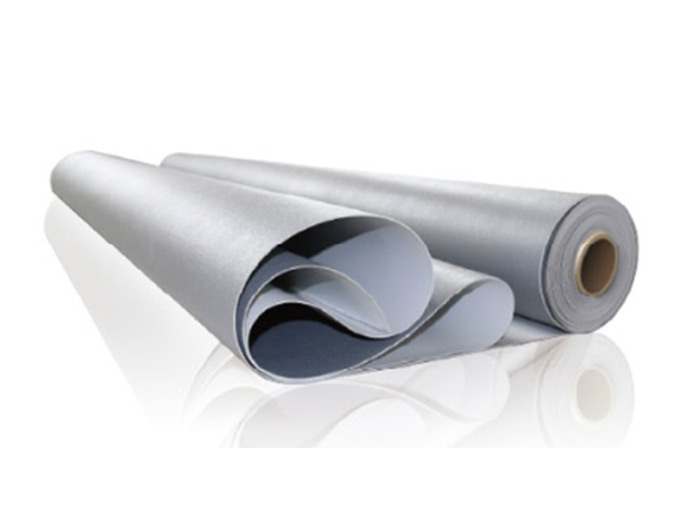Thermoplastic polyolefin (TPO) waterproof coil (referred to as TPO waterproof coil) is made of TPO resin, which combines the weatherability and heat resistance of ethylene propylene (EP) rubber with the weldability of polypropylene. In the early 1990s, it was applied to roof waterproof engineering by mechanical fixed paving. Because it has both the weatherability of EPDM rubber, and the weldability of plastic waterproof coil, the waterproof effect is reliable, and the aging resistance is outstanding.
?
So it's growing fast. With its excellent physical and chemical properties and environmental performance, the coil has become the fastest growing waterproof material in the world today. In the United States, TPO waterproof coil has accounted for 24% of the U.S. low-grade commercial roofing material market, and has maintained an annual growth rate of more than 23%. In recent years, with the development of mechanically fixed single-layer roofing system, TPO waterproof coil with high performance, energy saving and environmental protection effects has also shown a rapid development momentum in China.
?
Variety specification
?
The main uses of the product are divided into
?
Enhanced TPO Waterproof Roll (H) : thermoplastic polyolefin waterproof roll reinforced with polyester fabric in the middle of the roll.
?
· Backing type TPO waterproof roll (L) : thermoplastic polyolefin waterproof roll made of polyester non-woven fabric composite on the lower surface of the roll.
?
Homogeneous TPO waterproof coil (P) : thermoplastic polyolefin waterproof coil without internal reinforcement material or backing composite.
?
Common size
?
Coil thickness (mm) Coil width (m) Coil length (m)
?
1.2,1.5,1.8,2.0 1.0,1.5,2.0 20,30
?
Product characteristics
?
1, the use of advanced polymerization technology to combine ethylene propylene rubber and polypropylene, both the excellent weather resistance of ethylene propylene rubber and the weldability of polypropylene.
?
2, special formulation technology, no need to add any plasticizer that is easy to make the material brittle, does not produce general hot welding sheet (such as PVC) due to plasticizer migration and brittle phenomenon, maintain long-term waterproof function.
?
3, excellent high and low temperature resistance, like rubber materials at 50℃ still maintain flexibility, maintain mechanical strength at higher temperatures.
?
4, chemical resistance, acid, alkali, salt, animal oil, vegetable oil, lubricating oil corrosion, algae, mold and other microbial growth resistance.
?
5, with excellent root puncture resistance function, can be used as a root puncture resistance coil for planting roof.
?
6, heat aging, good dimensional stability.
?
7, mainly white light surface, smooth surface, high reflectivity, energy saving effect and pollution resistance.
?
8, the ingredients do not contain plasticizers and chlorinated polymers, welding and use of the process without harmful gas generation and release, harmless to the environment and human health.
?
9. The lap joint is constructed by hot welding, which can form a reliable sealing waterproof layer with high strength.
?
10. The enhanced TPO waterproof coil is sandwpled with a layer of polyester fiber fabric, which provides the coil with high tensile properties, high tear strength, fatigue resistance and puncture resistance, and is more suitable for mechanical fixed roofing systems.
?
11. The fabric on the bottom surface of the backing TPO waterproof coil makes the coil easier to bond with the base.
?
12. Homogeneous TPO waterproof coil has good plasticity and can be processed into various shapes after heating to adapt to complex nodes.
?
Scope of application
?
Mainly applicable to industrial and civil buildings, public buildings and other types of roof waterproof projects.
?
-- H enhanced coil is suitable for roofing waterproof system with mechanical fixing or empty roof pressing;
?
-- L backing coil is suitable for the base full sticky or empty roof pressing roof waterproof system;
?
-- P homogeneous waterproof coil is mainly used as a flooding material.
?
Thermoplastic polyolefin (TPO) single-layer roofing system
?
TPO single-layer roofing system refers to the use of single-layer TPO waterproof coil exposed to use, with mechanical fixed, full adhesive, empty roof pressing method for construction roofing system.
?
First, TPO mechanical fixed single-layer roof system
?
1. The TPO coil roofing system is generally mechanically fixed, that is, the enhanced TPO coil is empty laid on the base (or has been fixed thermal insulation board), and is fixed with mechanical fastening screws and fixed gaskets in the adjacent lower coil lap area. The upper coil covers the mechanical fasteners of the lower coil, and the lap of the upper coil and the lower coil adopts hot air welding. A waterproof layer that connects the coils into an integral seal.
?
Second, TPO full adhesive single-layer roof system
?
The backing TPO waterproof coil is fully bonded to the concrete or cement mortar base, and the adjacent TPO coil is welded by hot air to form an overall single-layer roof waterproof system.
?
Third, TPO empty roof single-layer roof system
?
The backing or enhanced waterproof coil is laid empty on the waterproof base, the adjacent TPO coil is welded with hot air, and the coil is roofed waterproof system with concrete paving block or pebble paving.
?
System main supporting materials
?
1. Homogeneous TPO prefabricated parts.
?
2, base adhesive, cutting edge sealing paste, general sealing paste, coil cleaning agent.
?
3, mechanical fixing screws, gaskets, metal layering and load distribution rope
?
Mechanical fixed single-layer system construction points
?
1, as the base of the steel plate thickness should be ≥0.75mm, and must have a reliable connection with the main structure, the connection between the steel plate should be smooth, continuous, without any sharp protrusions, the concrete base should be flat, dry, no honeycomb, cracks and other defects.
?
2, TPO coil prelaying: the coil should be placed for 15 to 30 minutes after laying and expanding to fully release the internal stress of the coil and avoid wrinkling during welding.
?
3, mechanical fixing of the lower coil: the fixed parts should be arranged straight and uniform, the spacing of the fixed parts should meet the design requirements, and the fixed parts should be encrypted in the surrounding and corner areas of the roof.
?
4, hot air welding: the upper coil covers the mechanical fasteners of the lower coil, forming a lap of not less than 120mm, the automatic welding machine is used to weld evenly, and the weld width is not less than 40mm. The contaminated lap part of the coil should be cleaned before welding.
?
5, detailed node processing:
?
The Yin and Yang corners, pipe roots, skylights and other details are made of TPO prefabricated parts or non-enhanced TPO flooding coils as waterproof layers, and the main waterproof layer is welded with hot air. Facade TPO coil ends are mechanically fixed with metal closing strips and finally sealed with sealing paste.
?
Full adhesive single-layer roof system construction points
?
1, the base should be dry, flat, no floating ash, coil bonding surface should be dry, clean and pollution-free.
?
2, before the use of the base adhesive should be stirred to uniform, on both sides of the base and the coil bonding surface evenly coated glue, glue must be continuous and uniform, to avoid brush leakage and accumulation, it is strictly prohibited to glue coating to the coil lap welding part.
?
3, put in the air for 5 to 10 minutes to dry the adhesive layer, until the hand touch is not sticky, roll the coil to the adhesive base bond, and roll with a special press roller to ensure that the bond is firm.
?
4, the adjacent two coils form 80mm lap, using automatic welding hot air welding.
?
5, the surrounding area of the roof should be fixed by metal layering.
?
Key points of construction of single layer roof system
?
1, the base should be dry, flat, no floating ash, coil bonding surface should be dry, clean and pollution-free.
?
2, TPO coil laying: the coil is empty on the base, after the coil laying, it should be placed for 15 to 30 minutes to fully release the internal stress of the coil and avoid wrinkling during welding. The two adjacent coils form 80mm lap joints and are welded with automatic hot air welding.
?
3. After the coil laying and welding is completed, the non-woven protective layer is laid in time, and the concrete paving block or pebble paving is used to avoid wind exposure. The surrounding area of the roof should be fixed by metal layering.
?
Construction precautions
?
1, the operator must be trained to work.
?
2, the surface of the welding material must be wiped clean, no water pollution, oil and dirt.
?
3, strictly focus on checking the welding quality, there should be no leakage welding, skip welding phenomenon.
?
4, pay attention to protection during the construction process, it is strictly prohibited to wear spikes into the construction site where TPO coils have been laid.
Hello, welcome to Weifang Jinqilin Waterproof Material Co., LTD website!
Service hotline:13853638286
- HOME
- ABOUT
- PRODUCTS
Customer first, quality first, good service, dedicated to serve you
- NEWS
Customer first, quality first, good service, dedicated to serve you
- CASE
Customer first, quality first, good service, dedicated to serve you
- EQUIPMENT
Customer first, quality first, good service, dedicated to serve you
- CONTACT
Customer first, quality first, good service, dedicated to serve you
- 中文


 Current position:
Current position:

 Asphalt waterproof coil
Asphalt waterproof coil Recommended news
Recommended news

 content details
content details 
 Business license
Business license